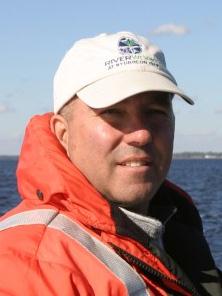JACKSONVILLE – As appearances go, little has changed at the old wastewater treatment plant in Jacksonville.
Concrete structures where tens of thousands of gallons of raw sewage were once sifted and churned still jut from the grounds overlooking the end of Wilson Bay on the New River.
Supporter Spotlight
The buildings are a significant part of the story of Riverworks at Sturgeon City, a memorial to how one community pulled together to reverse the devastation caused by years of dumping sewage into the bay.
 J.P. McCann |
Like the changes that have taken place beneath Wilson Bay’s rippling surface, what’s happening on the land is giving the old sewer plant a new life of its own.
Visitors to Sturgeon City can look forward to what’s ahead for the environmental teaching ground and aquatic research center.
“We have real world examples of science at work and we want to be able to use that,” said J.P. McCann, Riverworks’ executive director. “We are reusing the infrastructure.”
Today, visitors can see a majority of the original structures – a square, two-story bio tower; four large round holding tanks; and a series of drying beds leading from the administration building to the water’s edge.
Supporter Spotlight
Sturgeon City’s visionaries wanted to reuse as much of the former plant as they could. Here, recycling is part of an education process designed to inspire the hundreds of people who visit here each year.
Guests of the site can enjoy its sprawling 26 acres. Half of the land, once a landfill, has been turned into a park with picnic tables, a playground and walkways leading to the bay.
The other 13 acres, separated by a chain link fence, is where the old sewage treatment plant rests. This is where the facility’s visitors are introduced to the Wilson Bay initiative, a project begun in the 1990s between the city and N.C. State University to restore aquatic life to the bay after treated sewage had been dumped into it for more than 40 years.
After closing the plant, city leaders intended to raze its structures and possibly sell the land. Dr. Jay Levine, a scientist working on the bay initiative, came up with the idea to use the plant’s large tanks to raise Atlantic sturgeon, bottom feeders that once thrived in the bay.
Raising and releasing the fish into the wild isn’t permitted so employees and volunteers here continued to focus on cleaning the bay. The initiative has paid off.
“We now have confirmed sightings of sturgeon in the river,” McCann said. “The rate, I think, has surprised most of the researchers. In the last fourteen years we have restored a healthy bottom out there.”
The lesson of how people can help retain and restore he environment is applied in a series of after school, weekend and summer programs for high school students at Sturgeon City.
These programs are designed to enhance their knowledge about science, aquaculture, math, and forensics and encourage them to volunteer.
There’s also a major aquaculture research component at the facility. Through a partnership with N.C. State University and the University of North Carolina at Wilmington and funded by N.C. Marine Biotech, research is currently being conducted on southern flounder in an effort to determine the most inexpensive and quickest ways to raise the fish.
Flounder raised in 5,000-gallon tanks lined within the facility’s only new building are sold to Asian markets in New York City and Raleigh. Fish are also sold to farmers at the local farmer’s market on weekends.
“We always want to be a working facility,” McCann said.
The tedious process of removing thousands of black, plastic media from the bio tank, which will be turned into an exhibit hall, has begun. Visitors can climb stairs to the top of the tank now, giving them a 360-degree view of the grounds.
Sturgeon City will eventually have regular visiting hours. For now, anyone interested in visiting the site must call and make an appointment.
“We’ll do a program for two people,” McCann said. “We like to say that our doors are always open.”
Two of the facility’s old buildings have been torn down, making way for what will be a new, 12,000-square-foot gateway building complete with restrooms and a bookstore. Construction on the welcome center is expected to begin late this year.
Some of decades-old buildings behind the welcome center will be converted into exhibit halls and plans are to turn one of the holding tanks into an aquarium.
Fresh coats of paint will be applied to the old structures. Walkways will wind around the facility. Trees and shrubs will be added to make the landscape more aesthetically pleasing.
Yes, there are many more changes to come at Riverworks at Sturgeon City.
“We have the commitment of funds,” McCann said. “We’re ready.”








